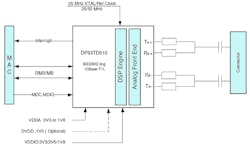New Ethernet Standard Solves Range Limitation for Industrial Apps
Download this article in PDF format.
Robert Metcalfe, David Boggs, and their associates really started something back in 1973 when they invented Ethernet. It started out as just one of many contenders for LAN supremacy and essentially won the battle.
Today, Ethernet is everywhere. It’s evolved from a 2.93-Mb/s and then 10-Mb/s coax-based technology to one that offers multiple standards using unshielded twisted pair (UTP) and fiber-optic cable with speeds over 100 Gb/s. Ethernet, standardized by the IEEE as “802.3,” now dominates the networking world. And the quest for more variations continues onward.
The general direction of Ethernet has been to continue to boost data rates with multiple physical-layer (PHY) variations. Coax was abandoned for UTP and speeds have increased by factors of 10 for the past decades. Today, UTP dominates, and speeds have passed the 100-Gb/s mark using multiple pairs. Standards groups are working on standards for rates of 800 Gb/s and beyond.
Another effort has been to make Ethernet suitable for other applications. Not too long ago, we got the slower 2.5- and 5-Gb/s adaptions of the 10GBASE-T standard, which is a better fit with existing cabling that supports Wi-Fi access points.
Another recent addition has been Automotive Ethernet, called 802.3bw or 100BASE-T1, that adapts Ethernet to the hostile automotive environment with a single pair. One of the newer single-pair standards is 802.3cg or 10BASE-T1L. This single-pair UTP 10-Mb/s connection can reach to 1 km.
Sponsored Resources:
- What is single-pair Ethernet?
- Extend network reach with IEEE 802.3cg 10BASE-T1L Ethernet PHYs
- Long-distance connectivity: 10BASE-T1L single-pair Ethernet PHY demo
Fixing an Ethernet Weakness
Ethernet’s main limitation has been its reach. Most Ethernet standards top out at 100 meters, which covers many if not most applications. But there are some instances where it’s just not enough. These include industry factory automation and process control for the deployment of some field transmitters and switches, sensors, and other equipment in large facilities with a long reach.
In building automation, long reach is often needed for HVAC, fire safety, and equipment like elevators. That’s why in some industrial applications, older fieldbus standards like 4-to 20-mA HART and others are still widely employed. They can sustain connections well beyond the usual Ethernet standard reach.
The Ethernet solution to this need is 10BASE-T1L, which uses a single UTP to cover up to 1000 meters. And with its ability to handle data rates to 10 Mb/s, it not only solves the range problem, but also lets industrial engineers increase their speed of communication. An added benefit is that it eliminates some protocol conversions, the need for gateways, and other adaptations that are often necessary in providing interoperability in an industrial setting.
Another benefit is that the single-pair requirement allows for the use of existing cabling. Running new cables is a major cost and time issue. Almost any single pair can be used, possibly including some existing fieldbus cables.
Ethernet is already used extensively in industry. Some standards cover the supervisory control needs; these connect to the usual IT/business network employed throughout industry. The new standard enables a way to include very remote sensors, meters, switches, and other necessities in this large network that can now extend to the edge.
A Closer Look at the Standard
The standard has two parts. The main offering is 10BASE-T1L, or long reach to 1 km. The connection is point-to-point (p2p) with full-duplex capability. The other is 10BASE-T1S, or short-reach option that provides p2p half-duplex coverage to 25 meters. This version includes multidrop possibilities and uses the standard Ethernet CSDMA/CD contention access method.
The PHY utilizes an unusual PAM3 4B3T line coding. The PAM3 means that there are three voltage levels to encode the data: a positive pulse, a negative pulse, and zero (e.g., + 0 -, - + 0, 0 + -, etc.). This is ternary code that, in effect, gives 33 = 27 combinations to represent 16 4-bit codes. These 16 codes are mapped to a three-symbol table. Not all of the three-symbol codes are used; for example, 000 isn’t included to avoid long strings to occur without a transition.
The encoding logic process is such that it keeps track of the dc level on the line and makes corrections to keep this dc bias to zero. This makes the baud or signaling rate three fourths of the bit rate—in this case, 7.5 MBd for a net 10-Mb/s data rate. No forward error correction (FEC) is used.
The pulses at 2.4-V p2p permit the 1000-meter range. A 1-V p2p option is used for a range less than 200 meters. Full-duplex transmission is achieved with an echo-cancellation scheme.
A key feature in this standard is its support for Power over Data Lines (PoDL). With this provision, the remote device can be powered by the equipment to which it’s connected—a major benefit in industrial applications.
Implementing 10BASE-T1L
While the 802.3cg standard was approved back in 2019, adoption activity has been minimal. It’s probably been due to the lack of appropriate IC transceivers to implement the PHY. However, one possibility is Texas Instruments’ DP83TD510E (see figure). This low-power 802.3cg PHY meets all of the standards’ rules and makes designing devices with this standard possible.
This device uses 38 mW in the 1-V p2p mode and 82 mW in the 2.4-V p2p mode. And, of course, it’s compatible with multiple Ethernet MAC interfaces, including, MII, RMII master/slave mode, RGMII, plus other special RMII modes.
Some additional helpful features are 25- and 50-MHz clock outputs and a diagnostics toolkit. The diagnostics allow for open and short detection, self-test with loopback provisions, multiple active link diagnostics, and a signal-quality indicator to determine cable degradation. The IC operates from a single 3.3-V supply. Packaging is a 5- × 5-mm QFN with 32 pins.
In summary, the 10BASE-T1L single-pair PHY was created to help industrial engineers implement their industrial IoT projects, boost data rates over longer distances, and at the same time consolidate their networks with one standard interface to simplify them as well as reduce costs.
Sponsored Resources:
About the Author

Lou Frenzel
Technical Contributing Editor
Lou Frenzel is a Contributing Technology Editor for Electronic Design Magazine where he writes articles and the blog Communique and other online material on the wireless, networking, and communications sectors. Lou interviews executives and engineers, attends conferences, and researches multiple areas. Lou has been writing in some capacity for ED since 2000.
Lou has 25+ years experience in the electronics industry as an engineer and manager. He has held VP level positions with Heathkit, McGraw Hill, and has 9 years of college teaching experience. Lou holds a bachelor’s degree from the University of Houston and a master’s degree from the University of Maryland. He is author of 28 books on computer and electronic subjects and lives in Bulverde, TX with his wife Joan. His website is www.loufrenzel.com.

